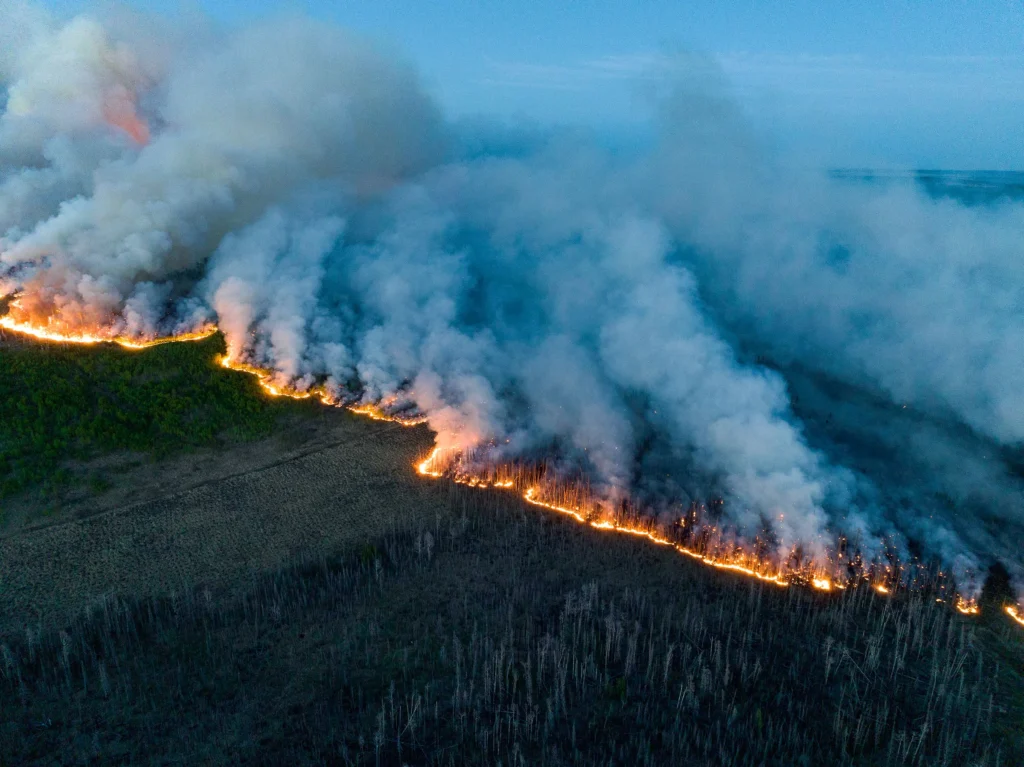
SAN JOSE – The wildfires that ravaged Canada in 2023 were a stark reminder of the devastating impacts of climate change. These infernos emitted more carbon dioxide into the atmosphere than India’s annual fossil fuel emissions, contributing significantly to global warming. According to a study by the World Resources Institute (WRI), the wildfires released 3.28 billion tons of CO2. This staggering amount highlights the scale of the disaster (World Resources Institute) (NOAA Research).
Extensive Forest Loss
The fires burned an area larger than West Virginia, totaling nearly 30,000 square miles, which is six times the average annual burn area from 2001 to 2022. This extensive burning accounted for 27% of global tree cover loss in 2023, a significant increase from the usual 6%. These figures underscore the severity of the fires and their contribution to atmospheric carbon levels, which are already at record highs.
The Role of Forests
Forests play a crucial role in sequestering carbon, storing it in their biomass and soil. When forests burn, this stored carbon is released back into the atmosphere, exacerbating the greenhouse effect. James MacCarthy, lead author of the WRI study, explained that the carbon stored in trees’ branches, trunks, leaves, and soil is released during fires, increasing atmospheric CO2 levels. This release was almost four times the annual emissions from global aviation and equivalent to the emissions from 647 million cars based on U.S. Environmental Protection Agency data.
Ecological and Health Impacts
The ecological impact of these wildfires extends beyond carbon emissions. The loss of such a vast expanse of forest disrupts ecosystems, affecting biodiversity and local climates. Although forests can eventually regenerate, the process takes decades. During this time, the loss of tree cover means reduced carbon sequestration, compounding the warming problem. Syracuse University professor Jacob Bendix noted that while forests will regrow and eventually sequester carbon again, the delay means a prolonged period of elevated atmospheric CO2, contributing to climate change.
Air Quality and Health
The health implications of the wildfires were also profound. Smoke from the fires drifted across large parts of North America, turning skies orange and reducing air quality in cities like New York. The smoky haze led to health warnings and affected millions of people. Alexandra Tyukavina, a co-author of the study, highlighted that air quality in populated areas was significantly impacted, posing health risks to residents.
Climate Change and Future Risks
Climate change played a significant role in the intensity and frequency of these fires. Warmer temperatures, drier conditions, and increased lightning strikes create a more fire-prone environment. The 2023 fire season in Canada was exceptional, with temperatures during May to October averaging nearly 4 degrees Fahrenheit higher than usual. Some regions experienced temperature anomalies as high as 14 to 18 degrees Fahrenheit. These conditions, driven by climate change, are expected to make such extreme fire seasons more common in the future.
Urgent Need for Action
Experts agree that addressing climate change is critical to mitigating the risk of future wildfires. This includes reducing greenhouse gas emissions, improving forest management practices, and investing in technologies for early fire detection and suppression. The catastrophic fires in Canada serve as a stark reminder of the urgent need for global action to combat climate change and protect our forests.
The global carbon budget is rapidly being exhausted, and events like the Canadian wildfires accelerate this process. The Intergovernmental Panel on Climate Change (IPCC) emphasizes the need for immediate and substantial reductions in carbon emissions to avoid surpassing critical temperature thresholds. If current emission trends continue, the world is likely to exceed the 1.5 degrees Celsius warming target within the next decade.
In conclusion, the Canadian wildfires of 2023 were not just a national disaster but a global environmental crisis. The massive carbon emissions, loss of tree cover, and health impacts underscore the interconnectedness of climate systems and the urgent need for comprehensive climate action. As we look to the future, it is clear that combating climate change and protecting our forests are essential steps in preventing such catastrophic events from becoming the new norm.


